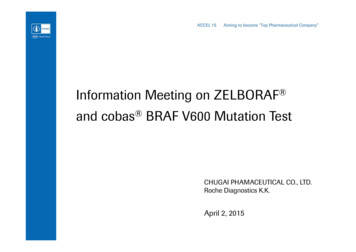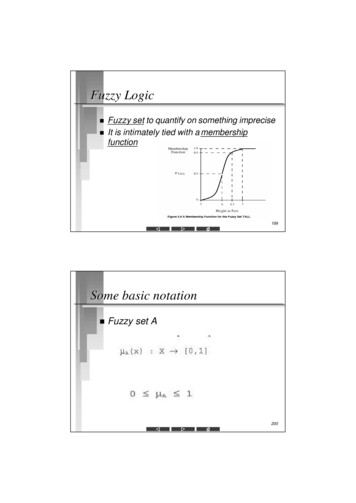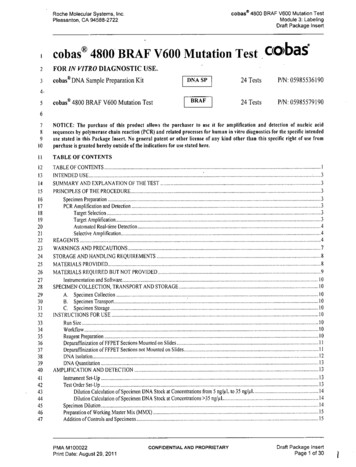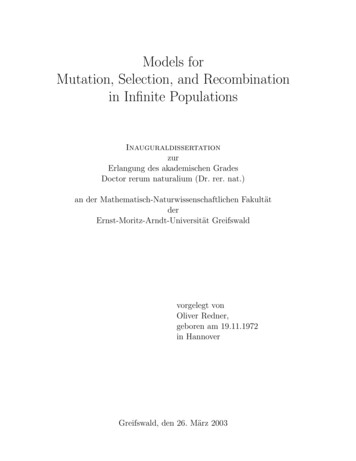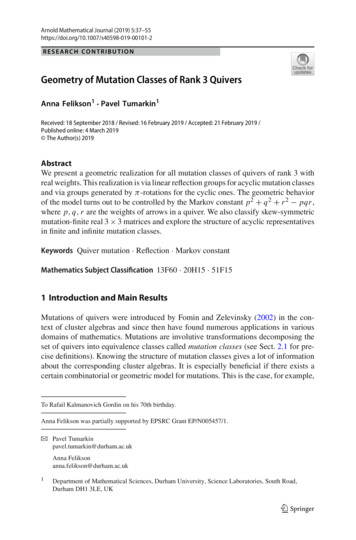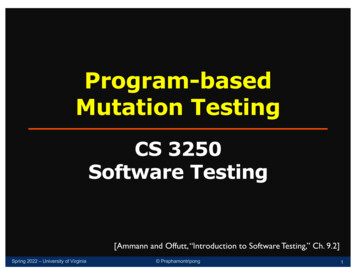
Transcription
Mutation models: probabilistic study and parameterestimationAdrien Mazoyer, supervised by Bernard YcartLaboratoire Jean Kuntzmann, UGA GRENOBLEJPS 2016Adrien Mazoyer (LJK)Mutation modelsJPS 20161 / 17
Example543time210mutation rate 0.05, fitness 1, death 0, cells 143, mutants 30exponential lifetimes(source : http://ljk.imag.fr/membres/Bernard.Ycart/)Adrien Mazoyer (LJK)Mutation modelsJPS 20162 / 17
e8 110 1.36e9 19.56e8 06.82e8 6Parameters of interest: π : Probability of mutation α : Mean number of mutations ρ : “Fitness”4.90e8Adrien Mazoyer (LJK).Mutation modelsJPS 20163 / 17
Mutation modelNumber of divisions tends to Mutation probability tends to 0 Asymptotic model Observation at time which tends to Adrien Mazoyer (LJK)Mutation modelsJPS 20164 / 17
Mutation modelNumber of divisions tends to Mutation probability tends to 0 Asymptotic model Observation at time which tends to 3 ingredientsOccurrences of random mutations during a growth process.Adrien Mazoyer (LJK)Mutation modelsJPS 20164 / 17
Mutation modelNumber of divisions tends to Mutation probability tends to 0 Asymptotic model Observation at time which tends to 3 ingredientsOccurrences of random mutations during a growth process. Poisson distribution (law of small numbers)Adrien Mazoyer (LJK)Mutation modelsJPS 20164 / 17
Mutation modelNumber of divisions tends to Mutation probability tends to 0 Asymptotic model Observation at time which tends to 3 ingredientsOccurrences of random mutations during a growth process. Poisson distribution (law of small numbers)Growth of a clone starting from a mutant cell for a random time.Adrien Mazoyer (LJK)Mutation modelsJPS 20164 / 17
Mutation modelNumber of divisions tends to Mutation probability tends to 0 Asymptotic model Observation at time which tends to 3 ingredientsOccurrences of random mutations during a growth process. Poisson distribution (law of small numbers)Growth of a clone starting from a mutant cell for a random time. Sequence of independent exponential times for each clone.Adrien Mazoyer (LJK)Mutation modelsJPS 20164 / 17
Mutation modelNumber of divisions tends to Mutation probability tends to 0 Asymptotic model Observation at time which tends to 3 ingredientsOccurrences of random mutations during a growth process. Poisson distribution (law of small numbers)Growth of a clone starting from a mutant cell for a random time. Sequence of independent exponential times for each clone.Number of cells in a mutant clone that develops for a finite time.Adrien Mazoyer (LJK)Mutation modelsJPS 20164 / 17
Mutation modelNumber of divisions tends to Mutation probability tends to 0 Asymptotic model Observation at time which tends to 3 ingredientsOccurrences of random mutations during a growth process. Poisson distribution (law of small numbers)Growth of a clone starting from a mutant cell for a random time. Sequence of independent exponential times for each clone.Number of cells in a mutant clone that develops for a finite time. Depends on model assumptions.Adrien Mazoyer (LJK)Mutation modelsJPS 20164 / 17
The Luria-Delbrück model (LD)AssumptionsAt time 0 a homogeneous culture of n normal cells.The generation time of any normal cell is a random variable withMalthusian parameter ν.A splitting α and π If L[z] E e zNg(z) L [π(h(z) 1)] ;Instead of π α/N :π Adrien Mazoyer (LJK)L 1 [exp (α(h(z) 1))];(h(z) 1)Mutation modelsJPS 201611 / 17
Bias sources: fluctuation of final count NInstead of being constant, N is a random variable.Link between α and π If L[z] E e zNg(z) L [π(h(z) 1)] ;Instead of π α/N :π L 1 [exp (α(h(z) 1))];(h(z) 1)In practice: only empirical mean and variance of are known;Reduce the bias using approximation of L.Adrien Mazoyer (LJK)Mutation modelsJPS 201611 / 17
Bias sources: lifetime distribution012time345543time210Lifetime is not exponentially distributed with rate µ.log normal lifetimesAdrien Mazoyer (LJK)exponential lifetimesMutation modelsJPS 201612 / 17
Bias sources: lifetime distribution012time345543time210Lifetime is not exponentially distributed with rate µ.log normal lifetimesexponential lifetimesFeatures of the new distributionµ is the Malthusian parameter of new lifetime distribution.Explicit distribution only for exponential and constant division times.Adrien Mazoyer (LJK)Mutation modelsJPS 201612 / 17
Bias sources: time homogeneityThe lifetime distribution depends on the birth time of the cell.Adrien Mazoyer (LJK)Mutation modelsJPS 201613 / 17
Bias sources: time homogeneityThe lifetime distribution depends on the birth time of the cell.New assumptionsThe generation time of a normal (resp. mutant) cell born at time s 0has cumulative distribution function Fν (s, t) 1 e ν(s,t)resp. Fµ (s, t) 1 e µ(s,t)where ν (resp. µ), is positive, differentiable and increasing, such thatlim ν(s, t) and t [0 ; s] , ν(s, t) 0 .t Adrien Mazoyer (LJK)Mutation modelsJPS 201613 / 17
ResultsMain Result (M.A.)As n , the final number of mutants at time tn , starting with n normalcells, converges to the distribution with probability generating functiong(z) exp {α(I(z, ) 1)} ,where I(z, t) depends on ν and µ.Adrien Mazoyer (LJK)Mutation modelsJPS 201614 / 17
ResultsMain Result (M.A.)As n , the final number of mutants at time tn , starting with n normalcells, converges to the distribution with probability generating functiong(z) exp {α(I(z, ) 1)} ,where I(z, t) depends on ν and µ.Particular case : µ(s, t) ν(s,t)ρAs n , the final number of mutants at time tn , starting with n normalcells, converges to the distribution with probability generating functiongα,ρ (z) exp(α(hρ (z) 1))where hρ (z) is the probability generating function of the Yule distributionwith parameter ρ.Adrien Mazoyer (LJK)Mutation modelsJPS 201614 / 17
Current and future worksTheoretical workResults for non-trivial cases.Extend to multitype branching processes.Including normal cell deaths.Adrien Mazoyer (LJK)Mutation modelsJPS 201615 / 17
Current and future worksTheoretical workResults for non-trivial cases.Extend to multitype branching processes.Including normal cell deaths.Practical workImplementation of the R package flan includingSimulation ;Estimation ;Statistical testsfor the different possible approaches.Adrien Mazoyer (LJK)Mutation modelsJPS 201615 / 17
RéférencesW. Angerer, An explicit representation of the Luria-Delbrückdistribution, J. Math. Biol., 42 (2001), pp. 145–174.K. Athreya and P. Ney, Branching processes, Springer BerlinHeidelberg, 1972.R. Bellman and T. Harris, On age-dependent binary branchingprocesses, Ann. Math., 55 (1952), pp. 280–295.A. Hamon and B. Ycart, Statistics for the Luria-Delbrückdistribution, Elect. J. Statist., 6 (2012), pp. 1251–1272.S. Luria and M. Delbrück, Mutations of bacteria from virussensitivity to virus resistance, Genetics, 28 (1943), pp. 491–511.Adrien Mazoyer (LJK)Mutation modelsJPS 201616 / 17
Thank you for your attention !Adrien Mazoyer (LJK)Mutation modelsJPS 201617 / 17
Mutation model Number of divisions tends to 1 Mutation probability tends to 0 Observation at time which tends to 1 9 ;)Asymptotic model 3 ingredients Occurrences of random mutations during a growth process.)Poisson distribution (law of small numbers) Growth of a clone starting from a mutant cell for a random time.
